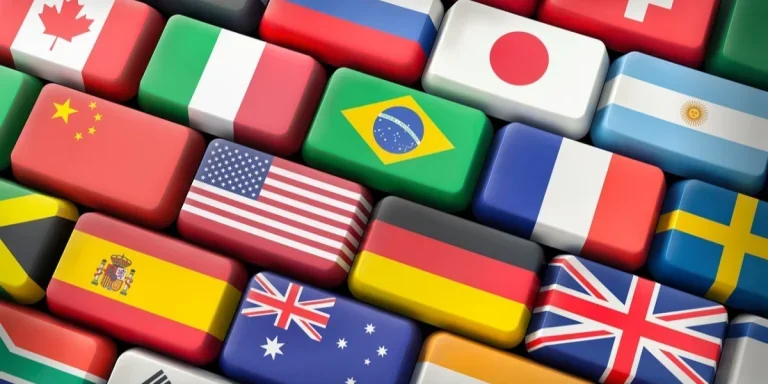The advent of the internet completely changed how small businesses and large companies operate and market themselves. The web quickly became the number one channel for selling products and services, finding new clients, raising brand awareness, and, most importantly, scaling one’s business into international markets.
While companies once mainly targeted consumers in their country of origin, it has never been easier to enter new markets and reach new potential customers simply by offering content in other local languages. That is why the importance of translation, and later localization, of websites has increased significantly over the years.
Simply translating content is no longer enough; website localization is essential for adapting a platform to the target audience’s cultural, linguistic, and market specifics. In this article, we’ll delve into the ways you can best localize your website and leverage global expansion.
Table of Contents
Website localization vs. translation: What’s the difference?
6 aspects of effective website localization
Conclusion
Website localization vs. translation: What’s the difference?

Although “website translation” and “website localization” are often used interchangeably, they represent two different concepts. Translation often involves converting a text from a source language to a target language, trying to maintain the original meaning without changing any information – here, the focus is on accuracy.
Localization, meanwhile, is a more complex and comprehensive process that includes translation but also goes beyond. When localizing a website, specialists adapt it to make it linguistically, culturally appropriate, and relevant to the target audience. That can include changing images, colors, date and time formats, currency, units of measurement, cultural references, and more.
A website can be considered successfully localized when it is perceived by native speakers of a country as being created by a fellow native speaker of a similar cultural background. This is key to building credibility among a new audience while ensuring the company’s mission, values, and messages are conveyed in the way they intend.
6 aspects of effective website localization
Every company should follow a few critical steps to localize their website effectively and successfully. Below are some tips to help ensure your website is not only understandable but also relevant and engaging to your target audience.
Understand the target market and language

Before starting the website localization process, it is essential to do thorough research on the target market and hire at least one professional from that country who can advise the company on cultural preferences, purchasing habits, local regulations, and consumer expectations.
Analyzing local competitors can also offer valuable insights into what works and doesn’t in a particular market.
Also, remember that using a Google Translator plugin or any other machine translation doesn’t mean localizing a website. On the contrary, it can hurt a company’s reputation and image, making a service feel less reliable and cheapening the product or service you’re offering.
Mind the tone
Localization goes beyond translating words and requires a cultural adaptation of the content, including cultural references and even the use of different tones and communication styles.
For example, English is a straightforward language that doesn’t feature any courtesy forms – “you” is just “you” no matter the relationship with the person you are talking with. There are, however, courtesy forms in Italian (“lei”) and French (“vous”). Yet, another quirk is that, despite these languages being so closely related, Italians don’t usually use the courtesy form on websites, while the French do.
This aspect becomes even more crucial when localizing a website for the Korean and Japanese markets, where honorific forms are highly valued and can change a sentence’s entire meaning and feel.
Keep an eye on design

Sometimes, localizing a website can mean needing to completely change its design. For example, this can be especially true for companies wanting to target Arabic-speaking countries since Arabic reads from right to left. Therefore, websites must mirror this orientation, including pictures, buttons, navigation, and other elements.
A website’s color scheme is also important. For example, colors considered auspicious in some cultures may have negative or different connotations in others. In China, red is the ultimate lucky color, while in many European countries, it can represent passion or love, and even danger.
Last but not least, images and illustrations of people must reflect the diversity and characteristics of the local audience.
More than numbers
Website localization pros know that elements such as dates, times, currencies, and units of measurement must be localized to be easily understandable by local audiences, especially when it comes to online stores that showcase prices, sizes, and deliveries.
For example, the United States uses the month/day/year format for dates, while many European countries use day/month/year. Similarly, units of measurement such as feet and pounds should be converted to meters and kilograms when targeting virtually any other country than the US.
Prices can also lead to misunderstandings. In English-speaking countries, a dot (.) is used as a decimal point, and commas (,) separate groups of thousands. However, in many European countries, it’s exactly the opposite, while in Russia and France, for example, thousands are separated by a space.
The importance of encoding
Using correct character encoding is essential when supporting different languages, alphabets, or sets of characters. UTF-8 (Unicode Transformation Format, 8-bit) is a widely-used character encoding system that supports many international characters and allows websites to display Latin, Cyrillic alphabets, special characters, and even Japanese and Chinese characters.
Website localization and SEO
Search engine optimization (SEO) is crucial as it helps drive traffic to a company’s website and makes sure content reaches its target audience when they search for relevant keywords online. However, people in different countries search for different things in different ways, and what works in one language may have a different search volume in another.
Before localizing a website, it’s essential to do keyword research specific to a target market and optimize your content accordingly. This also means your website should feature localized URLs, ALT tags, meta descriptions, etc.
Conclusion

Website localization is a crucial investment for any business wanting to expand into new markets. In addition to ensuring that content is understandable, this process helps a website resonate with local audiences and provides an optimal user experience.
By following the advice and best practices outlined above, you can better overcome language and cultural barriers and build a solid and successful online presence for your business in global markets.




